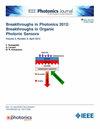利用 SPR 传感器评估不同氟化玻璃纤维和拓扑绝缘体 BSTS 对皮质醇传感的影响
IF 2.1
4区 工程技术
Q3 ENGINEERING, ELECTRICAL & ELECTRONIC
引用次数: 0
摘要
研究人员利用表面等离子体共振 (SPR) 传感器研究了不同类型的氟化物玻璃芯纤维(包括氟锆酸酯(ZrF4 基)、氟铝酸酯(AlF3 基)和氟铟酸酯(InF3 基)三大类)在检测唾液皮质醇方面的效果。这些传感器由多层组成,包括氟化玻璃芯、金属(Ag)、介质和介质光栅(SiO2)。在对不同浓度的皮质醇进行金属层厚度优化并保持其他参数不变的情况下,比较评估了传感器在 830 纳米波长下的优点系数(FOM)和检测限(LOD)。基于 InF3 组的 IZBSC 成分(40 InF3-20 ZnF2-15 BaF2-20 SrF2-5 CaF2)的最大 FOM 为 20.83 RIU-1,从而使强度检测法的 LOD 达到 0.986 fg/mL。与之前报告的结果相比,这是一个巨大的进步。此外,通过首次将拓扑绝缘体 Bi1.5 Sb0.5 Te1.8 Se1.2 (BSTS) 与 ZBLAN 光纤一起应用到该传感器中,LOD 降低到了 0.54 fg/mL,显示了皮质醇传感能力的显著进步。本文章由计算机程序翻译,如有差异,请以英文原文为准。
Evaluating Different Fluoride Glass Fibers and Topological Insulator BSTS Impact on Cortisol Sensing Utilizing SPR Sensor
The effects of different types of fluoride glass core fibers, from three main groups of fluorozirconate (ZrF
4
-based), fluoroaluminate (AlF
3
-based), and fluoroindate (InF
3
-based) fibers, were investigated in sensing salivary cortisol utilizing surface plasmon resonance (SPR) sensors. These sensors comprised multiple layers, including fluoride glass core, metal (Ag), dielectric, and dielectric grating (SiO
2
). The comparison was conducted to evaluate the sensor's figure of merit (FOM) and limit of detection (LOD) at 830 nm wavelength while optimizing the thickness of metal layer for different concentration of cortisol and keeping other parameters constant. The largest FOM of 20.83 RIU
−1
was observed for the composition of IZBSC (40 InF
3
-20 ZnF
2
-15 BaF
2
-20 SrF
2
-5 CaF
2
) from InF
3
-based group, resulting in an exceptional LOD of 0.986 fg/mL with the intensity interrogation method. This represents a tremendous advancement compared to prior reported results. Furthermore, by implementing a topological insulator Bi
1.5
Sb
0.5
Te
1.8
Se
1.2
(BSTS) into this sensor with a ZBLAN fiber for the first time, the LOD was reduced to 0.54 fg/mL, demonstrating remarkable progress in cortisol sensing capability best to our knowledge.
求助全文
通过发布文献求助,成功后即可免费获取论文全文。
去求助
来源期刊

IEEE Photonics Journal
ENGINEERING, ELECTRICAL & ELECTRONIC-OPTICS
CiteScore
4.50
自引率
8.30%
发文量
489
审稿时长
1.4 months
期刊介绍:
Breakthroughs in the generation of light and in its control and utilization have given rise to the field of Photonics, a rapidly expanding area of science and technology with major technological and economic impact. Photonics integrates quantum electronics and optics to accelerate progress in the generation of novel photon sources and in their utilization in emerging applications at the micro and nano scales spanning from the far-infrared/THz to the x-ray region of the electromagnetic spectrum. IEEE Photonics Journal is an online-only journal dedicated to the rapid disclosure of top-quality peer-reviewed research at the forefront of all areas of photonics. Contributions addressing issues ranging from fundamental understanding to emerging technologies and applications are within the scope of the Journal. The Journal includes topics in: Photon sources from far infrared to X-rays, Photonics materials and engineered photonic structures, Integrated optics and optoelectronic, Ultrafast, attosecond, high field and short wavelength photonics, Biophotonics, including DNA photonics, Nanophotonics, Magnetophotonics, Fundamentals of light propagation and interaction; nonlinear effects, Optical data storage, Fiber optics and optical communications devices, systems, and technologies, Micro Opto Electro Mechanical Systems (MOEMS), Microwave photonics, Optical Sensors.
 求助内容:
求助内容: 应助结果提醒方式:
应助结果提醒方式:


